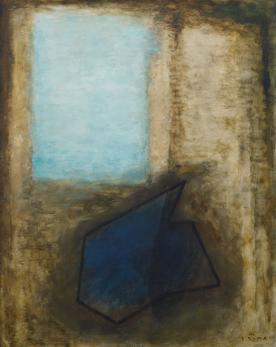Lot #72

Josef Šíma (1891–1971)
Antaeus
Estimate: 15,000,000 CZK - 20,000,000 CZK
8,000,000 CZK
Antaeus is a remarkable painting from the “Orpheus Cycle,” created after the author’s long creative silence, in which the artist returned repeatedly to the mythological motif of the Door of Orpheus as a symbol of the transition between worlds. The mythological subject of the giant Antaeus – the son of the sea god Poseidon and the earth goddess Gaia – finds a personal resonance in Šíma’s work. In Greek mythology, Antaeus, who draws his superhuman strength from contact with Mother Earth, was invincible as long as he stood with his feet on the ground. Only Heracles managed to outwit the giant by suspending him in the air, breaking his connection to the live-giving earth and triumphing over him in this weakened state. This symbolic overcoming of gravity and transcendence of the material world became, in Šíma’s interpretation, a meditation on existential boundaries. The fascination with the theme of transition between the worlds of life and death has a deeply personal dimension in the context of the painter’s life. Beginning in the postwar years, Šíma suffered from chronic heart disease which caused dangerous conditions of breathlessness and unconsciousness from lack of oxygen. His regular correspondence with his compatriot, the New York-based cardiac surgeon Josef Brumlík, testifies to this existential uncertainty. The doctor tracked the painter’s health remotely and sent him medicines then unavailable in Europe, thus literally “keeping him alive” for over a quarter century until his death in 1971.
Šíma’s abstraction in the painting is not a mere formal experiment, but an expression of a deeper philosophical conviction about the union of spirit and matter, the individual and the cosmos, which pervades his later work. The design of the painting’s composition and colouration reveals his masterful control of matter and light, through which he builds a tension between material and spiritual principles. Subtle transitions between the golden tones of the background cause the ethereal bluish rays of a symbolic Orpheus’s Door to another world to stand out. The dark, geometric shape with varying shades of blue in the lower part of the canvas then evokes the character of Antaeus unbound from the Earth, i.e. in his moment of greatest vulnerability, before mighty Heracles’s strike – this darkly incandescent stone emanates its shadowy rays in an attempt to reach the azure light of Orpheus’s Door. In this work, the painter continues the transformation of his prewar artistic language into a new form – “informal structure” – in which specific figural motifs dissolve into abstract colour fields without losing their symbolic meaning. When this work was created, Šíma’s career was experiencing an important renaissance. After a period in which he was relatively forgotten, his paintings began to appear on the Paris scene to great acclaim, first in the Kléber Gallery in 1955 and even more so from 1959, when the artist signed a contract with Paulo Facchetti, an important gallerist of Italian origin, who exhibited works by artists such as Karl Appel, Jean Dubuffet, Jackson Pollock, Michel Tapié and Henri Michaux in the 1950s. Unlike many of his peers, Šíma did not succumb to current trends, but remained focused on developing his internal universe, which oscillates, in later works like Antaeus, between lyrical abstraction and spiritual contemplation. The mythological story of Antaeus and Heracles is transformed here into a timeless metaphor about vulnerability and strength and life and rebirth – themes the painter researched with remarkable intensity and spiritual depth. The provenance of the work is also very interesting. It was first exhibited in Paul Facchetti’s Paris gallery in 1959 (Joseph Sima, Galerie Paul Facchetti, Paris 1959, no. 30F), from which it first entered the collection of Šíma’s admirer Jean Audouin. Subsequently, it was transferred to the Le Point Cardinal gallery, owned by Jean Hugues, the painter’s friend and final gallerist, who later also became the executor of his estate. From Hugues, the painting entered the collection of Thessa Herald, former director of the Fondation L’Oréal (Artcurial), who later sold it to one of the most important Swiss collections in Geneva in her 2001 exhibition (Joseph Sima dans sa lumière, Galerie Thessa Herold, Paris 2001, repro. p. 25 and on the cover of the catalogue). Antaeus was also published in a monograph by František Šmejkal (Josef Šíma, Prague 1988, p. 307, black and white reproduction no. 333) and in the book L. Bydžovská / K. Srp: Návrat Thesův (The Return of Theseus), Prague, 2007, p. 140, fig. 126; and presented at the exhibition Sima – Le Grand Jeu (3 April – 21 June 1992, Musée d’Art Moderne de la Ville de Paris, Paris 1992, cat. no. 82, repro p. 131, a reprise of the exhibition took place at the Riding School at Prague Castle). Assessed in consultation with Prof. J. Zemina and PhDr. R. Michalová, PhD. The expert opinion of PhDr. K. Srp is attached: “[...] The painting Antaeus can be designated as groundbreaking, as it brings together the main motifs of Šíma’s work as well as the methods of his painterly approach. Its deep, emotional impact is rooted in the contradictions of the extreme expressive positions of both motifs and the way Šíma interpreted the dialectic of the elements. From the perspective of his evolution as a painter, this is a significant work that substantially enriches the prior understanding of Šíma’s work. [...].”





